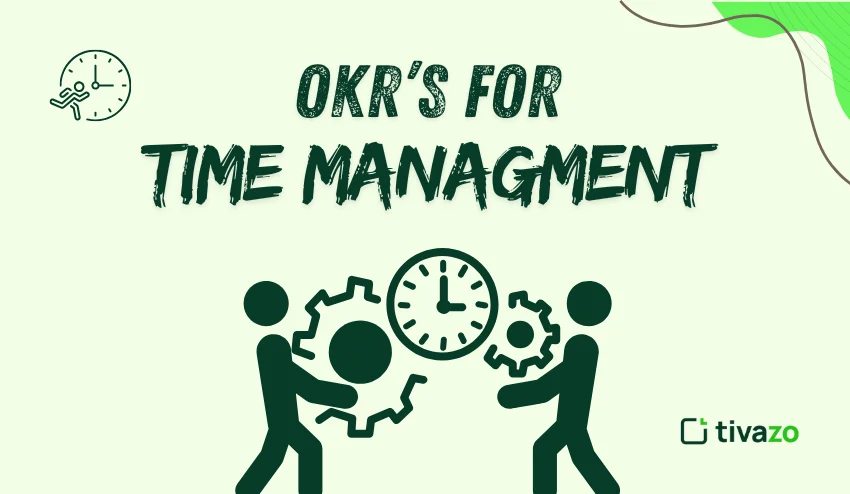People everywhere are trying to stay ahead of distractions and numerous demands on their time. As such, a definite skill for professionals and teams is understanding (Objectives and Key Results) OKRs for time management as a time management tool. You may find yourself battling procrastination, endless meetings, inefficient workflows, or even the feeling of being stuck. OKRs are a well-tested methodology that brings structure, accountability, and clarity to your time.
In this resource, we’ll take a look at OKRs for time management, what they are, how to do them, some common pitfalls, and real examples to help you get started designing them for your own use. By the end, you will be ready to develop OKRs that will improve the way you plan, prioritize, and perform daily.
What is OKR?
OKR is the abbreviation for Objectives and Key Results, which is a structure for setting goals and tracking progress by measuring specific results.
- An objective is a qualitative statement or the words you use to describe what you want to achieve.
- Key results are quantitative, measurable results that show how, finally, you’ll know you’ve achieved it.
For example:
Objective: To improve the team’s time management and efficiency.
- KR1: Reduce meeting time by 30%.
- KR2: Complete 95% of the tasks by the deadline.
- KR3: Decrease the response time to internal emails by 25%.
By having an objective with a few measurable levels or outcomes, you can turn your abstract goal into actionable steps. This works particularly well for time management, where having some structure and measurement is important.
Why Use OKRs to Manage Time
Time can be one of the most precious and limited resources. Utilizing OKRs allows teams and individuals to prioritize their time, rather than react to distractions. When you map out objectives and key results, you create a framework that leverages time as a strategic tool. Here are some key benefits of OKRs for time management:
- Clarity: You define what your time should be spent on and work on eliminating additional tasks that are not necessary.
- Alignment: Everyone can be assured that their time is being spent on work that aligns with the larger organizational objectives.
- Accountability: Measurable KRs can hold you accountable to your progress.
- Productivity: You can focus on high-value work that creates results.
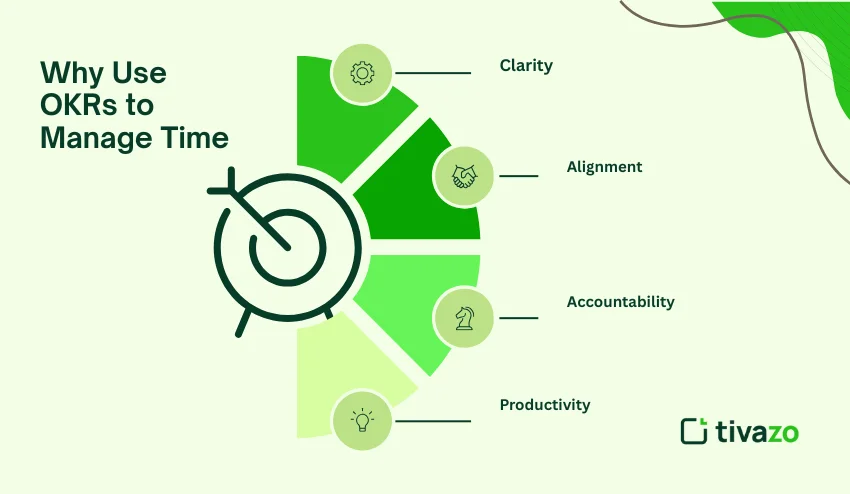
With good OKRs, you are not just tracking time, but you are using time wisely. OKRs for time management allow you to be intentional with every opportunity, minimize task/context switching, and turn long-term goals into milestones of smaller achievable goals. OKRs for time management ultimately allow teams to stay disciplined, motivated, and results-focused with each project cycle.
What Are the OKRs for Time Management?
When developing OKRs related to time management, you should aim to develop a system that supports increased efficiency and focus, ultimately improving output. OKRs provide a structure to prioritize work that has a significant impact, reduce wasted time, and establish a means of accountability for people and teams.
It feels better to manage time when everyone understands what the goals are and how many results you can track that measure time and productivity performance. With a clearly defined objective and measurable key results, you can see progress, remove bottlenecks, and identify areas for future improvement.
Example OKRs for Time Management:
| Objective | Key Results |
| Increase time utilization | -Decrease meetings by 25% time -Complete the top 3 priorities of the day each day (before noon) -Account for 100% of work hours for 30 days |
| Increase focus and reduce distraction | – Limit the amount of Multitasking to less than 10% of daily work – Achieve 4 uninterrupted deep work hours daily -Limit the number of checks on Slack/email to 3 times daily |
| Improve team scheduling of work | – Automate at least 50% of recurring scheduling -Achieve 90% on-time attendance for meetings – Implement a weekly time for the team to audit time |
Each of the OKRs for time management has a realistic, measurable target that will demonstrate improved time performance, and give you confidence that every time/task is making a meaningful response to productivity and goal achievement.
The 5Ps of Time Management
If you want to increase the effectiveness of the goals you create with your time management process, think about applying the 5Ps model – a time-tested framework to help ensure your framework is maintainable and organized. The 5Ps serve as reminders for individuals and teams to remain organized, focused, and consistent in accomplishing their goals, while limiting wasted effort.
When you consciously incorporate the 5Ps into the workflow daily, you turn the OKRs for time management framework into a structured system of discipline that supports short-term tasks and long-term projects and goals, while making it easier to review key progress indicators and adapt your plans accordingly.
5Ps Description
- Prioritize: Determine what is truly important. Direct your attention to tasks that lead directly toward the development of your key objectives’ results.
- Plan: Create a clear plan to accomplish your objectives. Reserve sufficient time in your week to devote to leading activities.
- Prepare: Anticipate obstacles you might incur and ensure you have the necessary tools and other important resources available to minimize lost time.
- Pay attention to your pace: Ensure your activities remain far too fast for sustainable productivity and cause burnout.
- Be persistent: The achievement of your key results will require self-discipline to maintain your goals over the long haul.
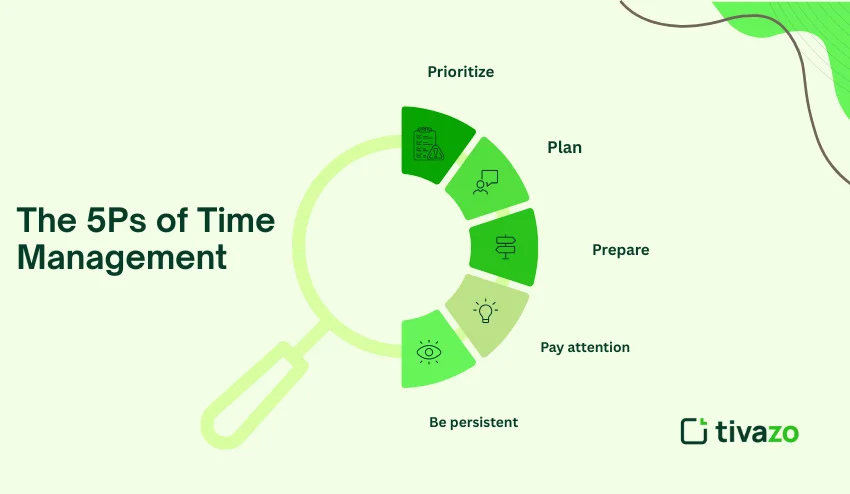
Good Examples of Time Management OKRs
Example 1: For Individuals
Objective: Enhance productive time and decrease wasted time.
- KR1: Complete 90% of today’s planned work by the end of the day.
- KR2: Maximize deep focus work for 4 hours each day.
- KR3: Evaluate and prepare the next day’s time plan each evening.
Example 2: For Teams
Objective: Enhance time efficiency for the team as a whole.
- KR1: Decrease average team meeting length from 60 minutes to 40 minutes.
- KR2: Meet 85% of project milestones on plan.
- KR3: Improve time allocation to strategic work by 20%.
Example 3: For Managers
Objective: Improve client time management on project delivery
- KR1: Deliver 95% of projects on time every month.
- KR2: Conduct time audits every other week and identify 3 areas for improvement.
- KR3: Develop and deploy 30% of repeat client report processes through automation.
These examples demonstrate the way OKRs for time management can be customized for each role.
Distinction Between Effective Time Management, Key Result, and To-Do List Element
| Criterion | To-Do Element | Effective Time Management Key Result |
| Focus | Task based | Outcome based |
| Measuring Success | Completion of the activity | Creating expected value and efficiencies |
| Short-term vs Long-term | Short-term task | Long-term outcome improvement |
| Example: | “Send report by 5:00 PM” | “Deliver weekly report within two hours to make processes more efficient by saving one hour each day.” |
In summary, a to-do item is what you did, whereas a key result assesses how successful you were at doing it. To-do things are often only about whether you did or completed something without consideration of the outcome or the level of efficiency achieved. Conversely, a good time management key result is often tying your daily tasks to better results or improved outcomes.
Usual Traps in Time Management OKRs
Tracking OKRs for time management can go wrong, even if using proper time tracking techniques, because of the best intentions.
Common areas of over-tracking OKRs for time management can include:
- Vague OKRs: We should not create KRs that say “manage my time better” because this is too vague. It is helpful to use a measurable metric.
- Too many OKRs: Try to limit yourself to 3–5 total OKRs at most; too many is confusing.
- Not taking the time to review: KRs require a weekly check-in to make sure they are relevant.
- Activity vs. outcome: We are assessing what is the outcome of tracking activity. (e.g., what impact does this have on my time saved, my efficiency, and improved finished work level).
- Not keeping aligned: Personal OKR tracks will all tie back to team or company goals.
To improve overall tracking issues, make sure all KRs are SMART: Specific, Measurable, Achievable, Relevant, and Time-bound.
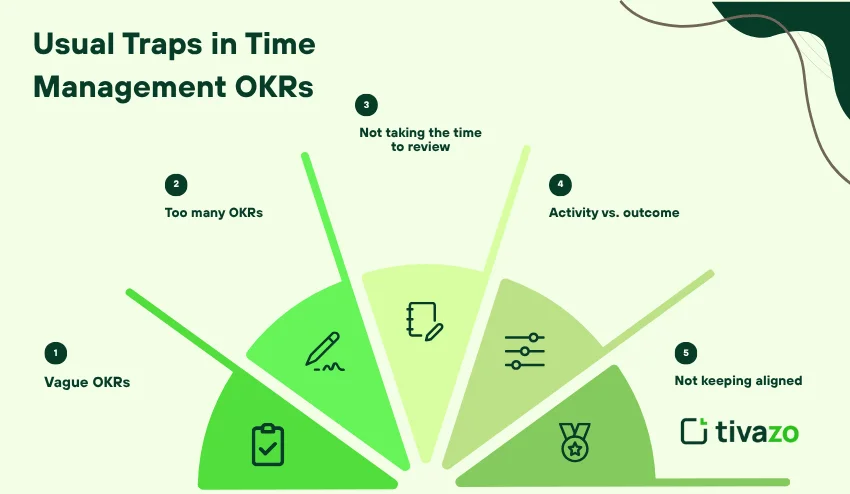
Ways to Write Effective OKRs for Time Management
To write OKRs for time management that can be referred to as concrete and effective, consider following these steps:
Ways to Write Effective OKRs for Time Management
- To write OKRs for time management that can be referred to as concrete and effective, consider following these steps:
- Identify your Objective: What specific improvement are you looking for?
- Develop 3–5 measures of success in the Key Results section: Use data that measures capability, not effort.
- Check and confirm that personal OKRs are aligned to a greater goal: Make sure to align personal objectives to the greater organizational direction.
- Collect and Measure Progress: Review in a meeting weekly, assess the data, improve if possible, and review any blockers to further progress.
- Celebrate Progress: Recognize even small progress, through small approvals, to maintain motivation.
Time Management: Individual vs. Team OKRs
When implementing OKRs for time management, first determine whether your focus will be on individual or team-level objectives.
Individual OKR
Works best as a productivity and workflow enhancement.
- Focus: Task Management, Deep Work, Self-Discipline
- Example: “Achieve at least 4 uninterrupted (focus) hours per day.”
Team OKR
Best applied for team responses and tasks.
- Focus: Meeting efficiency, project delivery, team alignment
- Example: “Achieve 90% of milestones on time without exceeding 10% overtime.”
Individual and Team OKRs must complement each other. If individual OKRs improve, Team OKRs will succeed and vice versa.
Incorporating OKRs for Time Management in Your Life
- Use tools: Use software like Asana, ClickUp, or Notion to track OKRs.
- Do productive time blocks: Identify time blocks for high-value tasks.
- Automate recurring tasks: Use automated workflows (Zapier, HubSpot) to save time on recurring tasks.
- Compare regularly: Review habits or tasks that support your OKRs.
Integrating OKRs for time management into your life allows you to go from theory to consistent behavioral practice toward a goal.
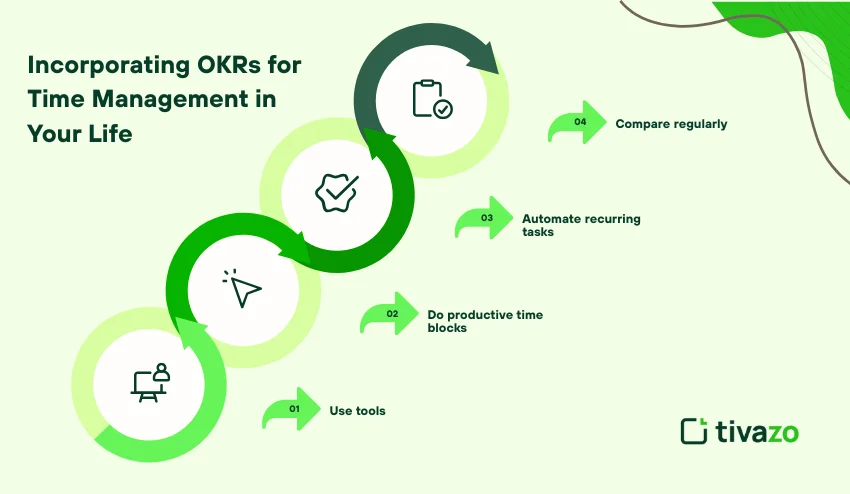
Summary
The significance of using OKRs for effective time management goes beyond just planning one’s schedule or to-do list, but more importantly, to realize that your time and energy are now better aligned to focus on your worthy ambitions. Using planned actions with clear objectives and measurable key results, both individuals and groups can elevate their focus, productivity, and accountability.
Taking a structure like the 5Ps of time management (Prioritize, Plan, Prepare, Pace, and Persist) helps keep you consistent in what you feel is important. OKRs, unlike a to-do list, emphasize outcomes instead of activity toward work and life improvement, resulting in longer-term benefits to you. Using OKRs effectively can help you remove distractions, improve effectiveness, and count your value of time down to every minute …(in a sense,) turning your time into a strategic asset as opposed to a limited resource.
